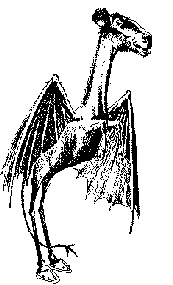Date of Discovery
The first reports of the Jersey Devil date back to Quaker and Founding Fathers times, around 1735 reports of sightings became a known and more experienced thing. To this day people report the devil to still be roaming among us and has become a staple to many household tales.
Name
Most commonly known as the Jersey Devil but originally called the Leeds Devil
Physical Description
Over 300 years of siting’s and reports have led to main versions of the Jersey Devil’s appearance, overall they can stick to three kinds of the descriptions; a horseman, a horse-bat, and a dragon-like horse. The most common features these reports all share are deep blood red glowing eye, bat-like wings sometimes having feathers one them, claws on elongated fingers, hoofed back legs, and a combination of fur and feathers across the body and neck. Depending on the over-all “class” of the devil some walk upright on the back legs, others stay true to more of a horse like posture walking on all four legs, and finally, a combination of a more dragon-like posture using each leg individually as well as being comfortable up-right on its back legs.
Origin
Originated from Pine Barrens, New Jersey USA around 1735 this devil-like creature has made its home across all of southern New Jersey. Over the next 300 years, American’s have reported the creature making its way all across the north-eastern states, even as low as Pennsylvania. There are two main theories as to how the Devil came into existent, both led back to the Leeds family who were founding settlers of the region as well as ex Quaker members. One of the most detailed reports of the Jersey Devil’s Real Story tells the tale from a more” fact-based” style rather then a man becomes a true monster-like creature.
Mythology & Lore
As the origin theories have some variation as to when and why the Leeds thirteenth son became Leeds Devil, most have molded legend around Mother Leeds rather than her husband’s tale. The legend started in 1735 when Mother Leeds was preparing for her thirteenth child. She was living a rather poor lifestyle with a drunkard husband who did little to provide for them. Upon a stroll through the wooded area of Pine Barrens she became so overwhelmed and exasperated with emotions, she proclaimed to the heavens “Let this one be the devil”. Unknowing of the curse she had put on her unborn child she continued through pregnancy as if all were normal. A few months later she went into labor in the Leeds Point home, and by all accounts from the midwives, everything appeared to be a normal delivery. As the womanly group cleaned and prepared the baby boy for the rest of the family to see, the child began to metamorphosis right before them into the most unholy beast. The infant grew at an incredible rate, sprouting horns from on top of its head, his fingers became talon-like claws, and feathers began to cover the large body. Leathery bat-like wings exploding from his back, and his eye began to glow bright red as well as becoming two sizes bigger. The devilish creature savagely attacked the womanly group that had just brought him into this world, before turning on the rest of the family who was just down the hall. Knocking down doors the creature hunted down all the family members it could find, only leaving few survivors before flying up the chimney and leaving a destroyed wake of rubble in its wake. It made Pine Barrens it’s home from then forward, harassing and terrorizing those unfortunate enough to stroll through its woods.
By the 18th and 19th centuries, the name was remade into the Jersey Devil rather than the Leeds Devil, as the creature was reported more spread through-out all of the southern New Jersey area. Residents to this day report unearthly wails coming from the forests, having their animals slaughtered, seeing the glowing red eyes hiding within bushes or trees, as well as a few reports of being attacked by the creature. The Devil has been sited from New Jerseys Pine Barrens area to the Delaware Valley, Camden, Bristol, and Philadelphia, Bridgeton, and Millville, and the list continues to grow more and more as modern culture accepts and adopts the tales and myths of the Jersey Devil. Many websites now keep special listings and accounts for Devil sightings, hoping to keep the community and creature hunter culture’s involved and up to date such as Weird NJ. The culture has even used this devil-like creature as a poster child for marketing and business adventures, even naming a hockey team after it. As it grows more popular the reported sightings take on more and more descriptions and behaviors the creature shows and develops.
Modern Pop-Culture References
Books & Literature
- The Jersey Devil (1976)
- The Legend of the Jersey Devil (2013)
- The Secret History of the Jersey Devil (2018)
Movies
- 13th Child: Legend of the Jersey Devil (2002)
- Leeds Point (2008)
- Carny (2009)
- The Barrens (2012)
- Jersey Devil (2014)
Is there anything we missed about the Jersey Devil? Let us know in the comments section below!



